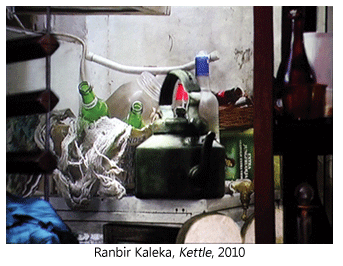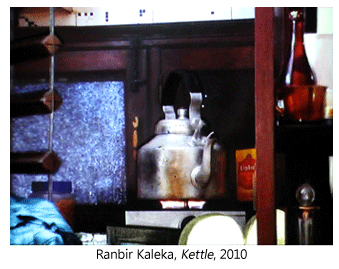- Prelude
- Editorial
- A Conversation with Jagdish Swaminathan
- Seeing is Very Important………
- Tormented Delineations and Violent Deformations
- Bikash Bhattacharjee: Subverting the Seen
- Bridging Western and Indian Modern Art: Francis Newton Souza
- Contesting National and the State: K K Hebbar's Modernist Project
- The Allegory of Return into the Crucial Courtyard
- Knowing Raza
- The Old Story Teller
- Beautiful and Bizarre: Art of Arpita Singh
- Feeling the Presence in Absence! Remembering Prabhakar Barwe
- Waterman's Ideal Fountain Pen
- Peepli Live: the Comic Satire Stripping off the Reality of Contemporary India
- Age of Aristocracy: Georgian Furniture
- Faking It - Our Own Fake Scams
- Scandalous Art and the “Global” Factor
- The Composed and Dignified Styles in Chinese Culture
- Visual Ventures into New Horizons: An Overview of Indian Modern Art Scenario
- The Top, Middle and Bottom Ends
- Top 5 Indian Artists by Sales Volume
- What Happened and What's Forthcoming
- The Month that was
- NESEA : A Colourful Mosaic
- Mumbai Art Sighting
- Art Events Kolkata
- Musings from Chennai
- Art Bengaluru
- Khoj, Kolkata Boat Project
- What a Summit!
- Ganesh Haloi at Art Motif
- The Other Self by Anupam Sud at Art Heritage, New Delhi
- Baul Fakir Utsav at Jadavpur
- Printmaking Workshop
- World's Greatest Never Before Seen Toy and Train Collection
- Previews
- In the News
- Christies: Jewellery Auction at South Kesington, London
ART news & views
Mumbai Art Sighting
Volume: 3 Issue No: 13 Month: 2 Year: 2011
December 2010 – January 2011
by Jasmine Shah Varma
This has been one of the most enriching months on the art scene with the solo exhibitions of senior artists - Ranbir Kaleka, Sudhir Patwardhan, Mehlli Gobhai and Dilip Ranade.
Man with a brush and a camera
 It's really a wonder why Delhi-based Ranbir Kaleka has never had a solo show in Mumbai before the one at Volte Gallery. His works have been extensively exhibited on international platforms. Hopefully there is a very good explanation for his works not showing more often in India. Man Threading a Needle is perhaps the only work shown in Mumbai 10 years back. The 58-year old Kaleka's medium of overlaying a painted canvas with moving video imagery is embedded in the minds of whoever had seen it.
It's really a wonder why Delhi-based Ranbir Kaleka has never had a solo show in Mumbai before the one at Volte Gallery. His works have been extensively exhibited on international platforms. Hopefully there is a very good explanation for his works not showing more often in India. Man Threading a Needle is perhaps the only work shown in Mumbai 10 years back. The 58-year old Kaleka's medium of overlaying a painted canvas with moving video imagery is embedded in the minds of whoever had seen it.
Sweet Unease treats us to seven select works made between 2000 and 2010 using the same technique. As with all-time memorable works of art, Kaleka's phantasmagorical accounts are accessible at various entry levels. There is something for all viewers to absorb. The sequential changing of the projected video scenes interspersed with the still imagery on the canvas is captivating. Unlike many video based works that depend on dry, boring, repetitive images or a documentary approach, Kaleka's is a dreamlike set-up where there is no linear narrative. A bunch of scenes are woven in such a manner that they leave an impression on the eyes and the mind. It's subtle and powerful psychological drama.
 Kettle (2010) is like the biography of a kettle. In the first scene the modest aluminum tea pot is seen sitting majestically in the clutter of a utensils shop. Thereafter, in the three-and-half-minute video projection on the painting of the kettle, we see the pot in a range of settings: in the field, a household, a jungle, a store room, on the stove, on fire, on a table and so on in a fluid sequence making us think about its travels. And in every carefully staged sequence, in the briefest of moments the mind builds a narrative around the same kettle. Temporality is central to the experience. Kaleka seems to be enquiring the relation of an object to its context and how the story changes with the surroundings. The kettle as a central object in this work gains metaphorical meaning. It gets us to review how we perceive, gather knowledge and construct opinion in any given situation and object in view.
Kettle (2010) is like the biography of a kettle. In the first scene the modest aluminum tea pot is seen sitting majestically in the clutter of a utensils shop. Thereafter, in the three-and-half-minute video projection on the painting of the kettle, we see the pot in a range of settings: in the field, a household, a jungle, a store room, on the stove, on fire, on a table and so on in a fluid sequence making us think about its travels. And in every carefully staged sequence, in the briefest of moments the mind builds a narrative around the same kettle. Temporality is central to the experience. Kaleka seems to be enquiring the relation of an object to its context and how the story changes with the surroundings. The kettle as a central object in this work gains metaphorical meaning. It gets us to review how we perceive, gather knowledge and construct opinion in any given situation and object in view.
The other works in the show are He Was a Good Man (2008) which is a tribute to Man Threading a Needle made in 1999. Also showing is the Man with Cockerel (2004), Fables from the House of Ibaan (2007), Not from Here (2010), Sweet Unease (2010) and Cul De-Sac in Taxila (2010).
After going through the layered and multiple narratives in each work it comes to mind how technology is merely a tool in the hands of Kaleka. Often artists using technology make us very aware of its mechanism. One has to hand to Kaleka for making the presence of technology, unassuming but effective.
Sweet Unease is on at Volte Gallery till February 16, 2011.
The Family Guy
Sudhir Patwardhan, the Mumbai based radiologist-turned-artist has shifted focus from the public to the private, from the streets to the interiors of homes, from viewing humanity in sociological contexts to reviewing relationships within the family. His latest solo show at Sakshi Gallery is titled Family Fiction and features new works painted over the last two years.
The joy is in the details in Patwardhan's paintings. The small, minute observations add up to make vast, telling, engrossing compositions, narrating the lives and predicament of his characters. To the familiar and universal experiences, he adds a dimension that makes us notice and relook. Take for instance, how he paints himself in Portrait. Rather than choosing a mirrored pose he goes for a self-image where you see his hand stretched out to reach the webcam  and the eyes resting on the viewer or the camera as it were. This reveals the contemporariness in handling of the age-old tradition of portraiture and the sincerity with which he approaches the disposition of his subjects, himself included.
and the eyes resting on the viewer or the camera as it were. This reveals the contemporariness in handling of the age-old tradition of portraiture and the sincerity with which he approaches the disposition of his subjects, himself included.
This self-portrait sets the mood in a way for the entire show which is a series of reflective paintings set in the interiors of the house with the wife, the children, the grandchildren, the constrictions within the walls of a Mumbai flat, the dreams, the facts and the window to the outside. We see familiar emotions and experiences in these paintings. Some works bring a smile to the face like the one called Watched where a ghostly face of a man emerges out of a whitish wall against which a boy is urinating. The Window series evokes the distinction between the two worlds of the inside and the outside separated by brick walls. The window carries many connotations a source of light, hope, the claustrophobia inside, warmth inside, the chaos outside, the jarring facts of city life and so on. He composes the walls, the outside views and the windows with discreet perspective, which has been a feature of Patwardhan's work for long. This is accomplished best in his panoramic composition Nostalgia where he has divided the canvas to show the homely interiors in one half and the other half showing the view of the city. In the first half we see two women standing in the balcony and the inside of the house where a man is sleeping, another one sitting and, the view on the other side of the flat through the window where we see a figure on a terrace. The encapsulating vastness of this composition on a canvas that is less than three feet by eight feet is overwhelming. The layered perspective showing the balcony, inside of house and beyond contrasts with the general zoomed out overview in the other half of the painting that shows the enormity of the city landscape.
Patwardhan describes the middle class core, its family values and, the tension and comfort in relationships. The physical aspects of houses play a large role in his narrative, as much as the evocative human body which has always been the central focus in his works.
'Family Fiction' concluded at Sakshi Gallery on January 27. It will show at the Lalit Kala Akademi, Delhi from March 5 to 11, 2011.79
Among other shows
 Gallery Chemould is showcasing New Works by Mumbai-based Mehlli Gobhai until February 10, 2011. The abstractionist is showing constructed canvases and works on paper. Gobhai's works are process oriented, where the material and the act of creating itself are the primary concerns. The surface suffused with layers of colours bears the feel of polished, aged metal. The latest works are high on linearity, which divides the planes creating tension and intensity. While a few works have the calm feeling of completeness, there are others that seem to be in the process of getting someplace and evoke the sense of structured chaos.
Gallery Chemould is showcasing New Works by Mumbai-based Mehlli Gobhai until February 10, 2011. The abstractionist is showing constructed canvases and works on paper. Gobhai's works are process oriented, where the material and the act of creating itself are the primary concerns. The surface suffused with layers of colours bears the feel of polished, aged metal. The latest works are high on linearity, which divides the planes creating tension and intensity. While a few works have the calm feeling of completeness, there are others that seem to be in the process of getting someplace and evoke the sense of structured chaos.
Pundole Art Gallery presented the works of Mumbai-based Dilip Ranade, senior curator at the Prince of Wales Museum. The Shimmer of the Self included recent paintings that recall surrealism of Rene Magritte, Ranade's cultural roots in Maharashtra, Indian political history, his experience in taxidermy and his present milieu. The striking imagery may come from his life, experience and observations, but he invites the viewer to engage with his works and find a narrative. The show concluded on January 29, 2011.